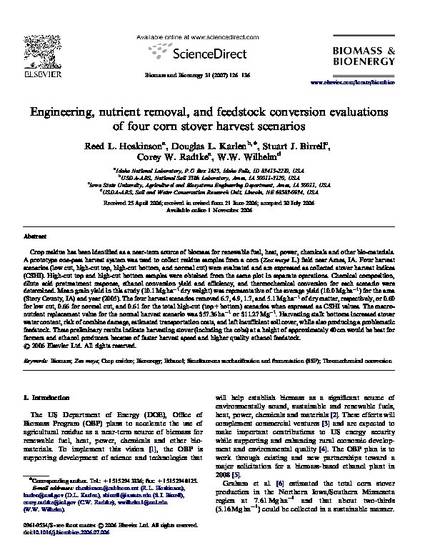
Crop residue has been identified as a near-term source of biomass for renewable fuel, heat, power, chemicals and other bio-materials. A prototype one-pass harvest system was used to collect residue samples from a corn (Zea mays L.) field near Ames, IA. Four harvest scenarios (low cut, high-cut top, high-cut bottom, and normal cut) were evaluated and are expressed as collected stover harvest indices (CSHI). High-cut top and high-cut bottom samples were obtained from the same plot in separate operations. Chemical composition, dilute acid pretreatment response, ethanol conversion yield and efficiency, and thermochemical conversion for each scenario were determined. Mean grain yield in this study (10.1 Mg ha−1 dry weight) was representative of the average yield (10.0 Mg ha−1) for the area (Story County, IA) and year (2005). The four harvest scenarios removed 6.7, 4.9, 1.7, and 5.1 Mg ha−1 of dry matter, respectively, or 0.60 for low cut, 0.66 for normal cut, and 0.61 for the total high-cut (top+bottom) scenarios when expressed as CSHI values. The macro-nutrient replacement value for the normal harvest scenario was $57.36 ha−1 or $11.27 Mg−1. Harvesting stalk bottoms increased stover water content, risk of combine damage, estimated transportation costs, and left insufficient soil cover, while also producing a problematic feedstock. These preliminary results indicate harvesting stover (including the cobs) at a height of approximately 40 cm would be best for farmers and ethanol producers because of faster harvest speed and higher quality ethanol feedstock.
Available at: http://works.bepress.com/douglas_karlen/56/

This article is from Biomass and Bioenergy 31 (2007): 126–136, doi:10.1016/j.biombioe.2006.07.006.